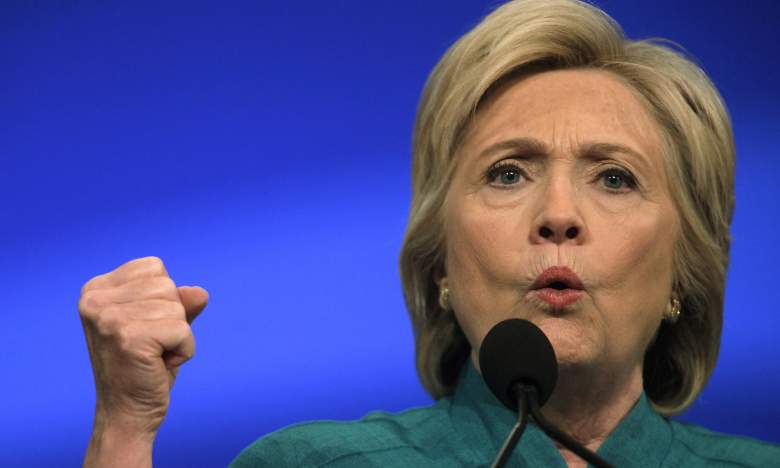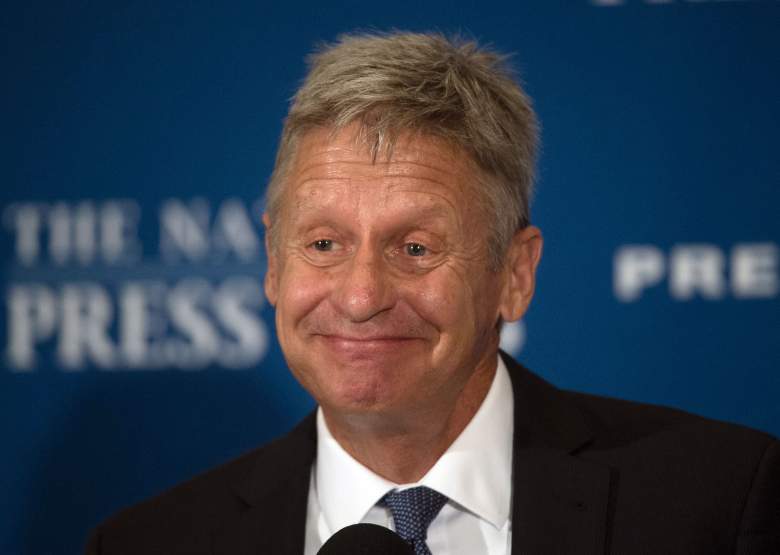
Democratic Presidential candidate Hillary Clinton addresses the (AFSCME) American Federation of State, County and Municipal Employees on July 19, 2016. (Getty Images)
Projects that predict elections using different methodologies mostly studying polls are forecasting a Hillary Clinton victory in November.
The forecasting models – which, on Aug. 3, were mostly predicting a more than 70 percent chance for a Clinton win in November – come in the wake of multiple polls showing Clinton received a bounce from the Democratic National Convention, perhaps buoyed by Donald Trump’s convention controversies, such as his war of words with Khizr and Ghazala Khan, the parents of a Muslim soldier who died in Iraq. That dispute extended past the convention’s end.
Clinton has weathered her own controversies, such as the WikiLeaks’ release of almost 20,000 Democratic National Committee emails that appeared to show DNC officials favoring Clinton over primary rival Bernie Sanders.
A Fox News poll on Aug. 3 shows Clinton with a 10 percent lead over Trump and a nine percent lead when Libertarian Gary Johnson is factored in; that’s up from her 6 percent margin in that poll a month ago. A Michigan poll released Aug. 4 is also good news for Clinton; it shows her leading Trump 41 percent to 32 percent, and she’s even leading in some Republican “strongholds” in the state, says The Detroit News.

Libertarian candidate for president, Gary Johnson. (Getty Images)
Election forecasting sites were all predicting on Aug. 3, using different statistical models in most cases, that Clinton stands the greatest chance of winning, although the exact percentages vary slightly. Still, they are remarkably consistent from site-to-site. She fares even better in Electoral College predictions.
RealClearPolitics averages major polls in the 2016 presidential race and had Clinton up by 5.1% on Aug. 2. Trump led briefly after the Republican National Convention in the polling average. RealClearPolitics provides a listing of all recent national and state polls in the presidential race.
Here are what major election forecasting sites are saying:
The Upshot
On Aug. 3, The New York Times’ Upshot page was forecasting that Clinton has about a 75 percent chance of winning the presidency.
According to Upshot, Trump could still win, but Clinton’s chance of losing is “the same as the probability that an NBA player will miss a free throw.” The Upshot election model is based on “the latest state and local polls.” The model looks at the latest state polls, a state’s past election results, and national polling, says The Upshot.
Upshot cautions that “candidates often receive a bounce around their party convention” and they are often temporary. The model favors state over national polling. Polling two to three weeks after the conventions will be more predictive, says The Upshot. The Upshot averages polls but focuses on long-term trends.
PredictWise
PredictWise is forecasting that the Democratic candidate has a 77 percent chance of winning, and the Republican has 23 percent. As with other models, PredictWise shows Clinton with a boost since the convention.
The model, by David Rothschild, reflects his “academic, peer-reviewed, research into prediction marks, polling and online/social media data.” The site describes Rothschild as an economist at Microsoft Research in New York City, but the site is not meant to represent Microsoft’s opinions.

Republican presidential candidate Donald Trump held a rally in Daytona Beach, Florida. (Getty)
FiveThirtyEight
On Aug. 3, FiveThirtyEight was predicting that Hillary Clinton has a 73.2 percent chance of winning the election.
The site shows a drop off in support for Trump after the Democratic National Convention, and is predicting that Hillary Clinton will receive 48.3% of the popular vote, with Trump receiving 43.6% and Libertarian Gary Johnson earning 6.8%.
The Electoral College is projected to be less close; FiveThirtyEight was predicting that Clinton would receive 322.5 electoral votes to Trump’s 215.2 and .3 for Johnson.
FiveThirtyEight says its model’s “win probabilities” come from “simulating the election 20,000 times, which produces a distribution of possible outcomes for each state.”
The site also calculates such things as how much each state matters by potentially tipping the election. Florida and Pennsylvania were ranked as having the highest “tipping point chance.” The forecast model also predicts “crazy and not-so crazy scenarios.”
For example, the site says that the chance of an Electoral College deadlock is only .4%, and the chance of Johnson winning a single electoral vote is 2.9%.
The site has a detailed page explaining how its model works. State polls are considered more important than national polls, for example. The site uses three versions to forecast the election: a model that combines polls with an economic index; a polls-only model; and a projection of “what would happen in a hypothetical election” if it were held today.
Princeton Election Consortium
This election forecasting site predicts that Clinton will receive 308 electoral votes to Trump’s 191.
The site says the probability of a Clinton win in November is at least 65%.
The Consortium says it uses meta-analysis including recent state polls, which “are used to estimate the probability of a Democratic/Republican win, state by state.” These are used to calculate the “probability distribution of electoral votes corresponding to all 2.3 quadrillion possible combinations.” The site has an article explaining its model.
Cook Political Report
Cook Political Report is predicting that 304 electoral votes will go for the Democrat and 190 for the Republican.
The Cook Political Report says it “is an independent, non-partisan newsletter that analyzes elections and campaigns.” Its most recent analysis on the 2016 presidential race says that the race is not over, despite the current media narrative that Trump is imploding. “Do I think Trump is a damaged candidate running a terrible campaign? Absolutely. Do I think that he has zero chance to win and has effectively lost the race in August? No,” wrote Amy Walter on the site.
She wrote that, because both candidates are “disliked and distrusted candidates,” it creates “much more fluidity and volatility” in the race than normal.